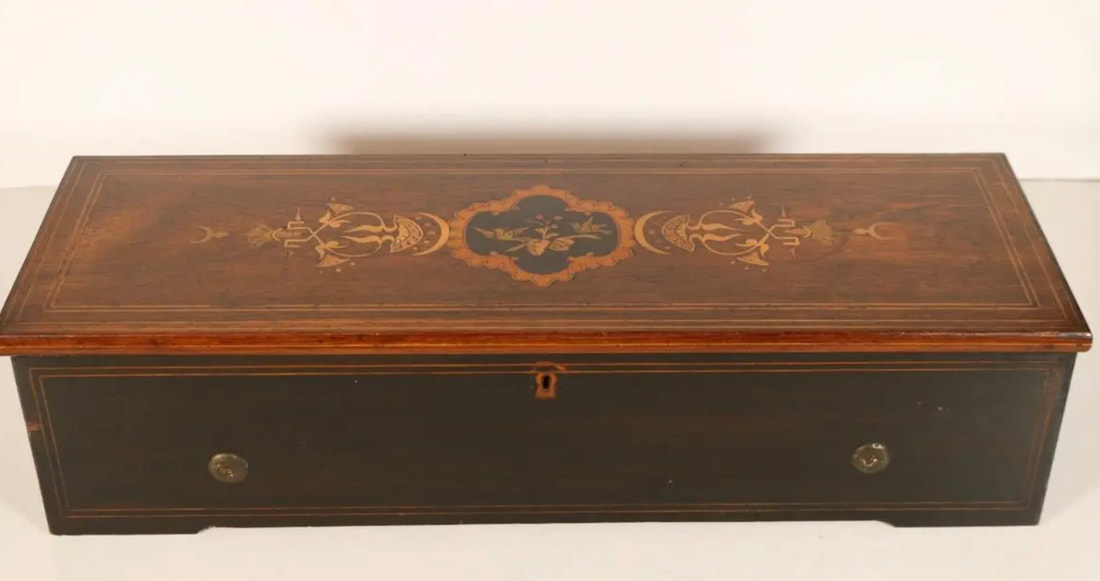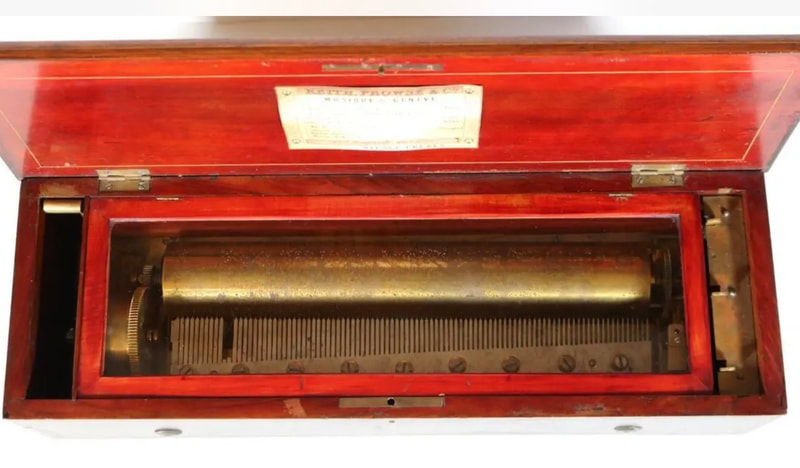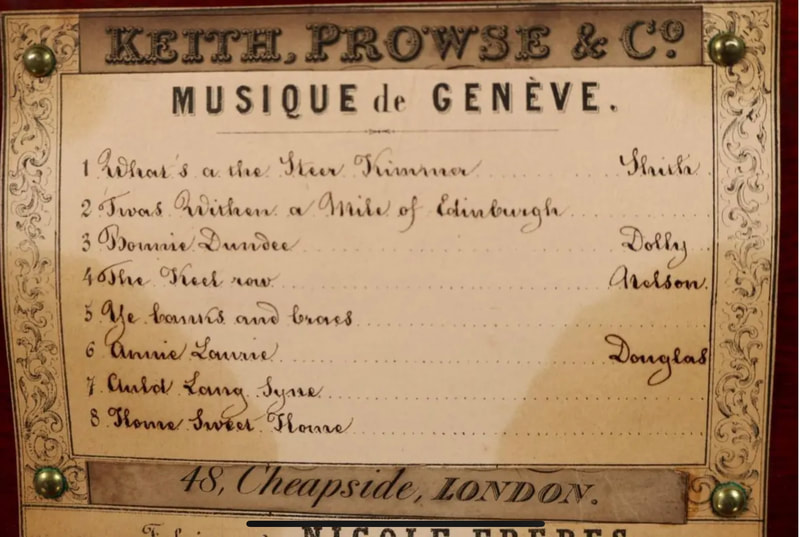8/97 Nicole Freres cartel Serial No. 40714 circa 1865
Bought from Time2remember on 5th November 2023
Originally imported and sold from Nicole Freres London showroom by Keith Prowse.
A fine marquetry box playing eight Scottish airs.
Needs cleaning, two new teeth and four new tips plus dampers (I suspect) plus the governor vanes are detached.
One for later in 2024
Originally imported and sold from Nicole Freres London showroom by Keith Prowse.
A fine marquetry box playing eight Scottish airs.
Needs cleaning, two new teeth and four new tips plus dampers (I suspect) plus the governor vanes are detached.
One for later in 2024
The Tunes
1. Wha's a' the Steer Kimmer is a highland fling in 4/4 time. Steer is Scots for ‘stir’, meaning to be in a bustle, or go about in a confused harassed way. A Kimmer is a married woman, midwife or a gossip, and Charles Gore adds that it is a fairly rude word for a young woman. Nigel Gatherer suggests the translation would be “What’s all this nonsense, woman?” The tune was sometimes used to accompany the Scottish country dance "Haughs o' Cromdale." The words to the popular song "What’s a' the Steer, Kimmer?" were written around 1840 by Robert Allan (1774–1841), music by Alexander Lee, and was published as a duet:
2. 'Twas Within a Mile of Edinburgh is an improved version of an old song supposed to have been written by Tom D'Urfey, towards the close of the 17th century, and entitled "'Twas within a furlong of Edinborough town." The old air is to be found in Oswald's collection: the air now in use is the composition of Mr. James Hook, father of the late Theodore Hook. The words here given are from the first volume of Johnson's Museum, 1787.
3. Bonnie Dundee is the title of a poem and a song written by Walter Scott in 1825 in honour of John Graham, 7th Laird of Claverhouse, who was created 1st Viscount Dundee in November 1688, then in 1689 led a Jacobite rising in which he died, becoming a Jacobite hero. Bonny Dundee is a very old Scottish folk-tune used for at least fifteen songs. A simpler version of the tune appears in the Skene manuscript around 1630 under the title Adew, Dundee. The title Bonny Dundee for the tune appears in an appendix to John Playford's 1688 edition of The Dancing Master, an English publication.
4. The Keel Row is a traditional Tyneside folk song evoking the life and work of the keelmen of Newcastle upon Tyne. A closely related song was first published in a Scottish collection of the 1770s, but may be considerably older, and it is unclear whether the tune is Scottish or English in origin.The opening lines of the song set it in Sandgate, that part of the quayside overlooking the River Tyne to the east of the city centre where the keelmen lived and which is still overlooked by the Keelmen's Hospital.
5. Ye Banks & Braes. "The Banks O' Doon" is a Scots song written by Robert Burns in 1791, sometimes known as "Ye Banks and Braes" (after the opening line of the third version). Burns set the lyrics to an air called The Caledonian Hunt's Delight. Its melodic schema was also used for Phule Phule Dhole Dhole, a song by Bengali poet Rabindranath Tagore,
The song was inspired by the story of Margaret (Peggy) Kennedy (1766—95), who was seduced and then abandoned by Andrew McDouall, the son of a wealthy family and sometime Member of Parliament for Wigtonshire. Kennedy sued for a declarator of marriage, but died prior to adjudication of the case. Although the Consistorial court found the marriage claim valid, the Court of Session decided the marriage claim failed, but found McDouall to be the father of Kennedy's daughter and ordered that he pay £3,000 to Kennedy's estate and provide for the child. (Burns wrote a second poem about Peggy, whom he had met when she was 18 - Young Peggy Blooms.)
The song uses the same tune as the East Anglian variant of the English Folk song "Foggy Dew".
The song was inspired by the story of Margaret (Peggy) Kennedy (1766—95), who was seduced and then abandoned by Andrew McDouall, the son of a wealthy family and sometime Member of Parliament for Wigtonshire. Kennedy sued for a declarator of marriage, but died prior to adjudication of the case. Although the Consistorial court found the marriage claim valid, the Court of Session decided the marriage claim failed, but found McDouall to be the father of Kennedy's daughter and ordered that he pay £3,000 to Kennedy's estate and provide for the child. (Burns wrote a second poem about Peggy, whom he had met when she was 18 - Young Peggy Blooms.)
The song uses the same tune as the East Anglian variant of the English Folk song "Foggy Dew".
6. Annie Laurie is an old Scottish song based on a poem said to have been written by William Douglas (1682?–1748) of Dumfriesshire, about his romance with Annie Laurie (1682–1764). The words were modified and the tune was added by Alicia Scott in 1834/5. The song is also known as "Maxwelton Braes".
7. Auld Lang Syne Traditionally, it is sung to bid farewell to the old year at the stroke of midnight on New Year's Eve/Hogmanay. By extension, it is also often heard at funerals, graduations, and as a farewell or ending to other occasions; for instance, many branches of the Scouting movement use it to close jamborees and other functions. The text is a Scots-language poem written by Robert Burns in 1788 but based on an older Scottish folk song. In 1799, it was set to a traditional tune, which has since become standard.
8 Home Sweet Home is an American Civil War song, originally an opera called Clari, or The Maid of Milan. The lyrics were written by John Howard Payne and set to music composed by Sir Henry Bishop in 1823




